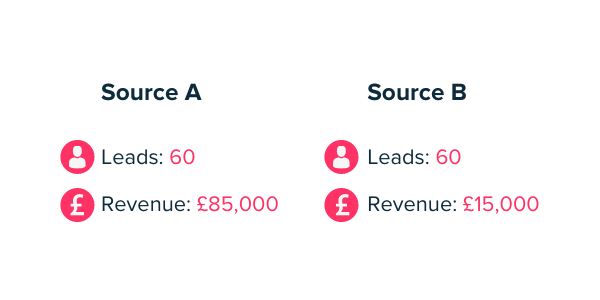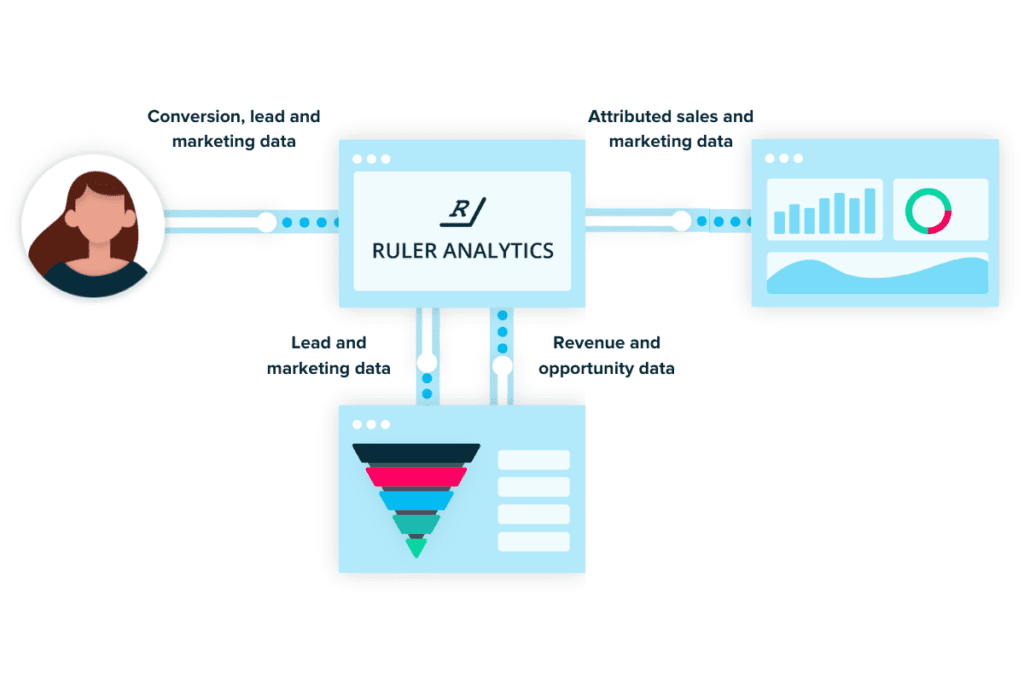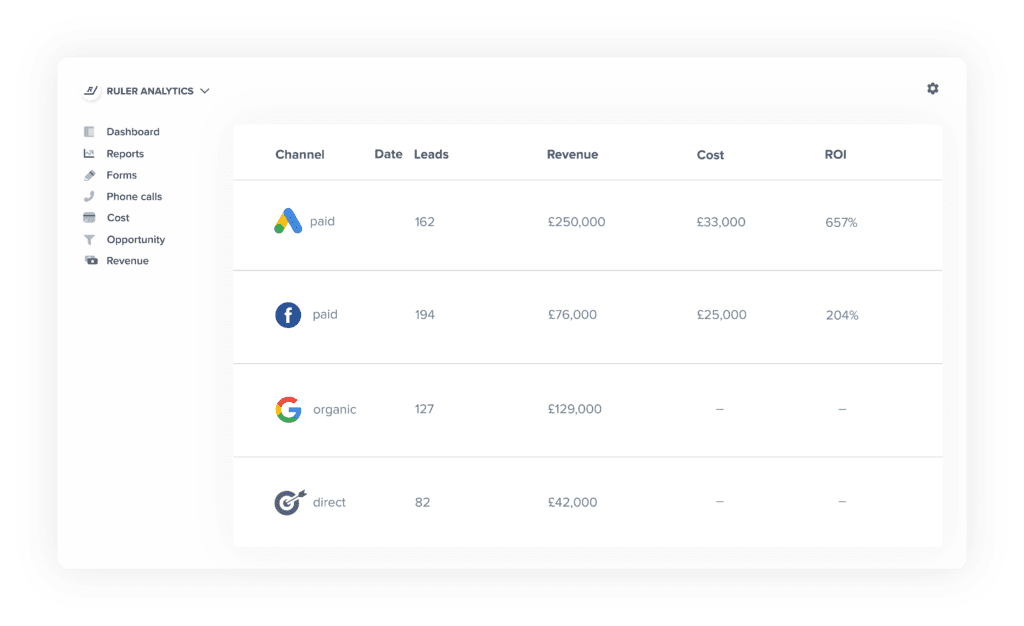Want to get started measuring lead value but not sure where to begin? We walk you through what lead value is, how you can calculate it and how to start tracking it for each and every lead.
The beginning of the month means one thing to marketers: the monthly marketing report. One common metric is lead volume. But what value is this actually showing? And how does it express the value your marketing team is driving?
Of course, you want to be generating leads, but tracking lead volume on its own isn’t enough.
For marketers, tracking lead value is difficult. But not impossible.
In this blog we’ll show you:
Related: Read our lead tracking cheatsheet
Ok, let’s get stuck in!
Not all leads are created equal.
A marketer’s job would be easy if all they had to do was generate leads. The trick is generating a large number of high-quality leads.
But what makes a high-quality lead? Well, it’s simple really. Revenue.
If a lead converts into a high-cost sale, then it’s high-quality.
Of course, this relies on your determining quality after leads have converted. But, there are often tell-tale signs of a lead being high-quality. They can include:
If you can determine these qualities in advance, you can get a better understanding of the quality of your leads. And, if you can attribute your revenue to your marketing in real-time, you can quickly identify where your most valuable leads come from.
💡 Pro Tip
Want to learn how you can better track your leads through the full customer journey? Download our guide to lead generation and tracking to see how you can go beyond lead volume
Lead value is the monetary value of your leads so you can make data-driven decisions to drive even more quality leads.
Knowing your lead value helps you forecast sales and justify marketing spend to acquire more customers.
While cost per lead helps you understand how much money you need to invest to drive new leads, lead value helps you understand how much your leads are worth.
But remember, a lead doesn’t guarantee a sale. While leads are great, they only get you so far…
Calculate your lead value with the following formula:

It’s surprisingly easy to underestimate the true value of your leads. It’s easy to just see your leads as contacts in a database. By understanding your lead value, you’ll get a good sense of how your marketing is working to bring in new prospects.
But what does lead value actually mean?
Let’s use an example to see the numbers in action.
Company A in 2021 brought in £100,000 of sales and revenue and their total number of leads in the year were 200.
That would give an average lead value of £500.
While this is a great starting point, it leaves us with a few questions:
Our fictional company, Company A, now has a rough idea of their average lead value.
But how does this help them optimise their marketing for their current opportunities?
It doesn’t help at all.
What they could do is find out their lead value by marketing channel. But there are issues here too.
Let’s use another example.
Let’s say Company A wants to compare two sources of lead data. The first, source A, is a list of leads who downloaded a white paper in return for their data. The second, source B, is paid-for outbound leads generated from a targeted search on a lead website.
Let’s recalculate the lead value. But this time, we’re going to split it by source.

Here, both sources had a total of 60 leads. Of which, Company A knows Source A generated £85,000. Meanwhile, Source B only generated £15,000.
Source A’s average lead value was therefore £1,416, while Source B’s average lead value was just £250.
So of course, Source A was much more fruitful in terms of generating revenue. Especially if you add in the fact that Company A would likely have had to pay for the leads generated in Source B.
In this example, we’re looking at two easy to track sources. But what about if those sources were organic traffic and pay-per-click traffic for example.
Here, Company A would struggle to track their lead value because:
So tracking lead value with fictitious data is pretty easy, right?
But, when you have anonymous visitors to your website converting into leads by many different methods, tracking each and then understanding lead value becomes really complicated.
Let us explain with an example.
Ella visits your website. She has a long customer journey, but she visits you via an email referral. Here, she calls and converts.
While you can track Ella as a new lead from a sales perspective and track her conversion from a marketing perspective, you can’t correlate the two data points.

Related: Marketing attribution software you need to check out
That means you can’t be sure what’s driving those new leads. And while you can track conversions, you can’t link them to real people to see if they go on to become sales.
The only way to link Ella, her organic session and the call she made to your business is through marketing attribution.
A marketing attribution tool will track every website visitor and collate their sessions and data using first-party cookies.

When they convert into a lead, their data will be fired over to your CRM. There, you’ll be able to see which channel drove that new lead.
Related: How to create an effective lead management process
But, even better, a marketing attribution tool will continue to track that user. So, when they close into a sale, it will scrape the revenue data from the CRM and fire it to the marketing channels you use most. There, it’ll be automatically attributed to the influencing channels, ads and keywords.
Using an attribution tool like Ruler Analytics means you can make smarter decisions for your business.
You can go beyond lead value and see accurate and real-time revenue in the marketing tools you use most. Tools like Ruler will help you:
Goodbye guesswork. With Ruler Analytics, you’ll be able to definitively prove how much revenue you’re driving through marketing.
In the Ruler dashboard, and in tools like Google Analytics and Facebook Ads Manager, you’ll be able to see an accurate revenue figure that’s attributed to your marketing channels, ads, campaigns and keywords.

Now you have revenue data in your favourite tools, you can easily prove the impact of marketing.
With Ruler in place, you can arm yourself with the data you need to prove how marketing is actively supporting and scaling your business.

Now you know what works when it comes to driving leads and revenue, you can optimise your outputs.
You can add resources or budget to what’s working well, and turn off what’s not working so well.
With real-time data, you can make quick decisions on how to improve your marketing.
Forget scrabbling after a campaign to compile results. With a tool like Ruler Analytics in place, you can track lead value and other key marketing metrics to prove your worth.
Learn more about how Ruler attributes revenue back to your marketing. Or, learn the three core ways Ruler can support your business to scale its profits.